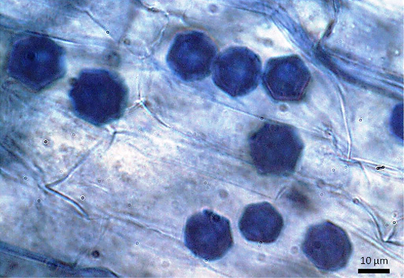|
by Cliff Bueno de Mesquita Happy Halloween! I just finished another round of root microscopy! We are interested in the ecology of fungal endophytes and often look at roots under the microscope to quantify how much of the root is colonized by fungi. While I focus on dark septate endophytes and mycorrhizal fungi (see previous posts), which are typically beneficial for plants, I also sometimes come across some pathogens in the roots. One such pathogen is the genus Olpidium. This genus of fungi has been of interest the agricultural field, as one species, Olpidium brassicae, has been shown to be a disease vector in a wide variety of plants including cucumber and lettuce plants. The fungus can infect lettuce roots, and transmit lettuce big-vein disease through its zoospores, which are the motile, asexual spores that Olpidium reproduces with (Tomlinson and Faithfull 1979). Another species, Olpidium radicale was shown to transmit melon necrotic spot virus disease in cucumbers (Tomlinson and Thomas 1986). A third species, Olpidium virulentus, can transmit olive mild mosaic virus (Reis Varanda et al. 2015). Another virus, tobacco necrosis virus, was also shown to be transmitted by Olpidium brassicae zoospores. This virus affects at least 88 different plant species, including tobacco, soybeans, and olive trees (Díaz-Cruz et al. 2017). Yikes! Fortunately for the alpine plants we study, Olpidium appears very rarely in their roots. Of the 35 plants we surveyed in 2016, only 5 of them contained Olpidium. When we do see it, the Olpidium cells are easily recognizable due to their distinct hexagonal shape (Figure 1). It remains unclear if this is an important pathogen for alpine plants or if it is causing them any harm.
References: Díaz-Cruz GA, Smith CM, Wiebe KF, Cassone BJ. 2017. First complete genome sequence of Tobacco necrosis virus Disolated from soybean and from North America. Genome Announce.5(32): e00781-17. Tomlinson JA, Faithfull EM. 1979. Effects of fungicides and surfactants on the zoospores of Olpidium brassicae. Ann. appl. Biol.93: 13-19. Tomlinson JA, Thomas BJ. 1986. Studies on melon necrotic spot virus disease of cucumber and on the control of the fungus vector (Olpidium radicale). Ann. appl. Biol.108: 71-80. Reis Varanda CM, Santos SJ, Esteves da Clara MI, do Rosário F. Félix M. 2015. Olive mild mosaic virus transmission by Olpidium virulentus. Euro. J. Plant. Path. DOI: 10.1007/s10658-015-0593-z.
2 Comments
|
AuthorVarious lab members contribute to the MoM Blog Archives
October 2023
Categories |


 RSS Feed
RSS Feed
